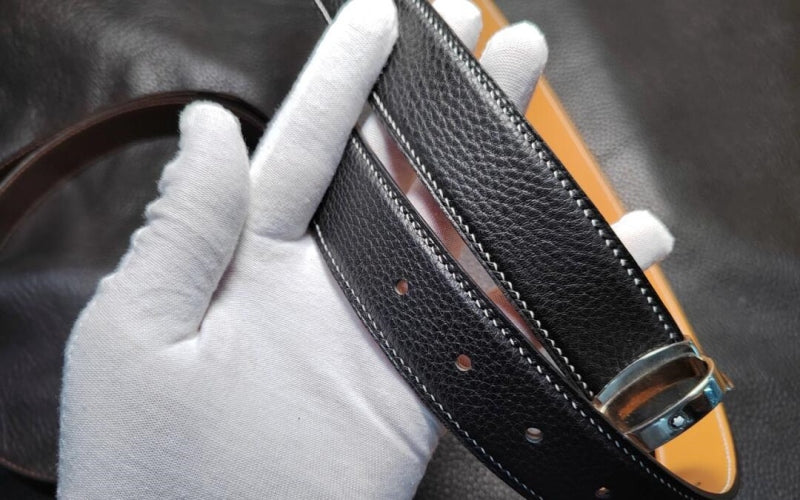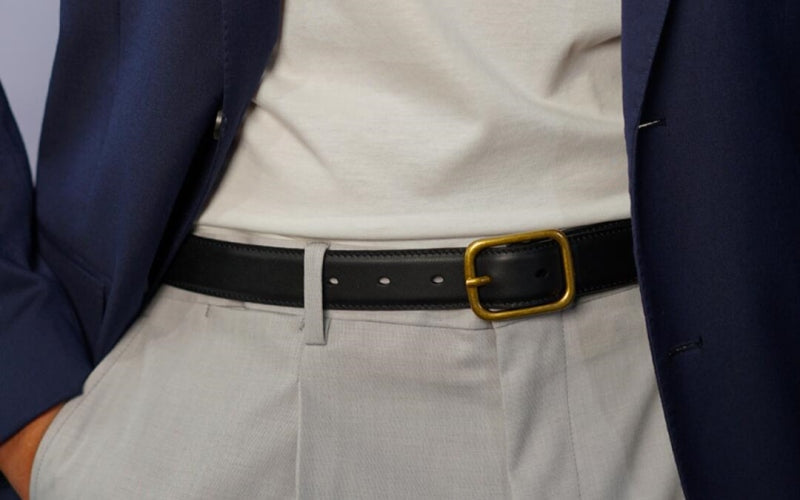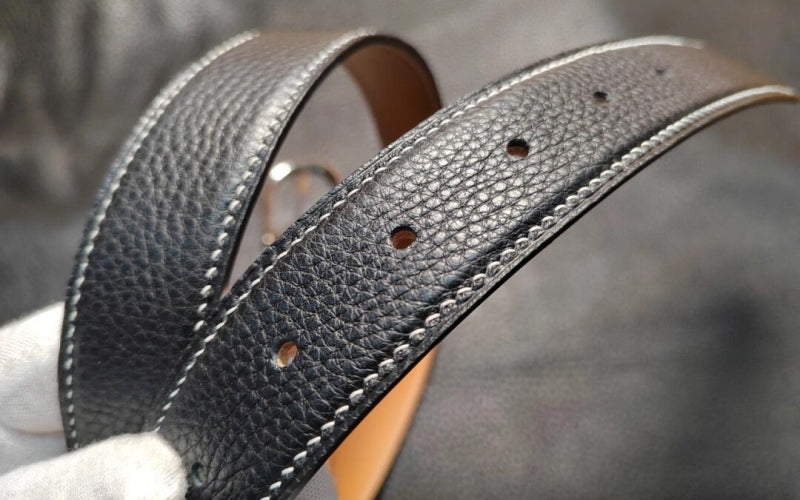
Who Makes the Best Leather Belt? (Spoiler: It’s Not Who You Think)
You’ve owned belts that disintegrated faster than your New Year’s resolutions. Maybe that $20 “genuine leather” special from the mall now resembles a dried-up raisin, or perhaps your “luxury” designer belt tarnished faster than a politician’s promise.
But here’s the kicker: Finding the best leather belt isn’t about the flashiest logo or the trendiest influencer endorsement. It’s about quality, craftsmanship, and a little secret we’ll unveil by the end of this guide.
In this no-holds-barred deep dive, we’ll dissect the titans of the belt world, expose overpriced posers, and reveal why Beltley—a brand you might not have heard of (yet)—is quietly dominating the game. Buckle up—this is the truth your wardrobe deserves.
 Love this belt? Tap the pic above to see more like it.
Love this belt? Tap the pic above to see more like it.
The Short Answer: The Best Leather Belts Are Made By…
Spoiler alert: It’s not the luxury houses charging $1,000 for a stamped “H” buckle.
The best leather belts come from brands that prioritize full-grain leather, handcrafted stitching, and ethical practices—all without the markup of a middleman.
But let’s rewind and break down why most belts fail (and how to spot a winner).
 Love this belt? Tap the pic above to see more like it.
Love this belt? Tap the pic above to see more like it.
1. The Anatomy of a Perfect Leather Belt
Before naming names, let’s define what makes a belt the best. Think of this as your “Leather Belt Bill of Rights”:
A. Full-Grain Leather
-
What It Is: The top layer of the hide, untouched by sanding or coatings.
-
Why It Matters: Durable, breathable, and ages like a fine wine, developing a unique patina.
-
Red Flag: If a brand vaguely says “genuine leather,” they’re hiding something.
B. Handcrafted Stitching
-
The Gold Standard: Saddle stitching (double-needle technique) that lasts decades.
-
The Poser: Machine stitching that frays like your patience in rush-hour traffic.
C. Solid Hardware
-
Best: Brass or stainless steel buckles with corrosion-resistant finishes.
-
Worst: Zinc alloy that tarnishes faster than a TikTok trend.
D. Ethical Production
-
Green Flags: Eco-friendly tanning, fair wages, zero sweatshops.
-
Red Flags: Vague “imported” labels + rock-bottom prices.
E. Warranty
-
Hero: Lifetime or 10-year warranties (confidence in craftsmanship).
-
Zero: 30-day return policies (they know it’ll fail).
 Love this belt? Tap the pic above to see more like it.
Love this belt? Tap the pic above to see more like it.
2. The Contenders: Breaking Down the Belt Giants
Let’s pit the heavyweights against each other in a battle royale:
A. Luxury Brands (Hermès, Gucci, Louis Vuitton)
-
Pros: Prestige, recognizable logos, decent craftsmanship.
-
Cons:
-
Markup Madness: $800–$1,500 for belts that cost $200 to make.
-
Coated Leather: Many use top-grain (not full-grain) to maintain a pristine look.
-
Ethics? Rarely transparent about sourcing or labor.
-
Verdict: Great for flexing, terrible for value.
B. Heritage Brands (Orion Leather, Tanner Goods)
-
Pros: Full-grain leather, hand-stitching, indie cred.
-
Cons:
-
Limited Styles: Rugged aesthetics (not for tailored suits).
-
Pricey: $150–$300 for minimalist designs.
-
Verdict: Solid for Americana fans, but not versatile.
C. Fast Fashion (H&M, Zara)
-
Pros: $15–$30, trendy colors.
-
Cons:
-
“Genuine Leather” = bonded scraps + plastic.
-
Lifespan: 3–6 months (if you’re lucky).
-
Verdict: The Kardashians of belts—all show, no substance.
D. Beltley (The Dark Horse)
-
Pros:
-
Full-Grain Leather: Thick, natural, and scratch-resistant.
-
Hand-Stitched: Double saddle-stitching that laughs at wear and tear.
-
Modular Design: Swap buckles for multiple looks (brass, silver, gunmetal).
-
Price: $145–$195 (with a 2-year warranty).
-
Cons:
-
No celebrity endorsements (yet).
-
You’ll have to explain “Beltley” to clueless friends.
-
Verdict: The Tesla of belts—innovative, ethical, and quietly revolutionary.
 Love this belt? Tap the pic above to see more like it.
Love this belt? Tap the pic above to see more like it.
3. The 5 Sneaky Tricks Brands Use to Scam You
Trick #1: The “Genuine Leather” Lie
-
Translation: A meaningless term hiding bonded leather or plastic coatings.
-
How to Fight Back: Demand specifics: “Is this full-grain or top-grain?”
Trick #2: The “Handmade” Hustle
-
Reality: Many “handmade” belts are machine-stitched in factories.
-
Red Flag: No close-up photos of stitching on product pages.
Trick #3: The “Heritage” Hype
-
Example: Brands citing “since 1900” but outsourcing labor to sweatshops.
-
How to Verify: Check their “About Us” page for workshop photos.
Trick #4: The “Free Gift” Trap
-
Example: “Free” belt with a $300 wallet purchase (spoiler: both are junk).
-
Pro Tip: Never pay for something you didn’t seek out.
Trick #5: The “Trendy” Distraction
-
Example: Logos, neon colors, or faux-vintage distressing.
-
Truth: Trends fade; quality doesn’t.
Love this belt? Tap the pic above to see more like it.
4. Why Beltley Beats the Luxury Giants (Without the Bloat)
Let’s dissect why this underdog deserves your attention:
A. Full-Grain Leather, No Compromises
-
Thickness: 3.5–4mm (luxury brands average 3mm).
-
Sourcing: Ethically tanned hides from eco-conscious suppliers.
-
Patina Power: Ages uniquely, telling your story—not a brand’s.
B. Handcrafted, Not Hand-Assembled
-
Process: Each belt is cut, stitched, and polished by artisans (not assembly lines).
-
Stitching: Waxed linen thread in a double saddle-stitch—won’t unravel.
C. Modular Magic
-
Swap Buckles: Match your belt to your shoes, watch, or mood.
-
Buckle Types: Brushed brass, polished silver, matte black.
D. Price Transparency
-
Cost Breakdown:
-
Leather: $60
-
Labor: $50
-
Buckle: $25
-
Profit: $20
-
Luxury Markup Comparison: Hermès spends $200 to make a belt, sells it for $1,000.
E. Sustainability
-
Zero Waste: Off-cuts become keychains or donated to artisans.
-
Eco Dyes: Vegetable-tanned, non-toxic.
 Love this belt? Tap the pic above to see more like it.
Love this belt? Tap the pic above to see more like it.
5. How to Spot a Junk Belt (Before It Breaks Mid-Meeting)
The Squeeze Test
-
Good Belt: Feels dense and supple.
-
Junk Belt: Feels hollow or stiff (like a library book cover).
The Sniff Test
-
Good Belt: Smells earthy and rich.
-
Junk Belt: Reeks of chemicals or synthetic plastic.
The Bend Test
-
Good Belt: Creases softly and bounces back.
-
Junk Belt: Cracks like a glow stick.
 Love this belt? Tap the pic above to see more like it.
Love this belt? Tap the pic above to see more like it.
6. The Cost-Per-Wear Reality Check
|
Belt Type |
Cost |
Lifespan |
Cost Per Year |
|
Fast Fashion |
$25 |
6 months |
$50 |
|
Luxury Designer |
$1,000 |
5 years |
$200 |
|
Beltley |
$165 |
15+ years |
$11 |
Verdict: Beltley costs less per year than a Netflix subscription.
7. The Beltley Difference: Testimonials From the Trenches
Case Study #1: The 10-Year Belt
-
User: Mark, Architect
-
Story: Bought a Beltley belt in 2015. Survived 3 job changes, 2 kids, and a dog. Now sports a honey-brown patina.
Case Study #2: The Traveler
-
User: Priya, Flight Attendant
-
Story: Swears by her reversible Beltley belt for transitioning from uniform to cocktail hour.
 Love this belt? Tap the pic above to see more like it.
Love this belt? Tap the pic above to see more like it.
8. FAQs: Your Belt Buying Dilemmas Solved
Q: Are designer belts worth it?
A: Only if you’re paying for the logo. For quality, Beltley matches them at 1/5th the price.
Q: Can I wear the same belt daily?
A: Yes—if it’s full-grain. Rotate occasionally to prevent stretching.
Q: How do I clean a leather belt?
A: Wipe with a damp cloth + condition every 3–6 months.
Q: Do Beltley belts come in widths for suits?
A: Yes! 1.25" for formal, 1.5" for casual.
Q: What if my Beltley belt breaks?
A: 2-year warranty. We’ll replace it, no questions asked.
9. The Final Verdict: Skip the Hype, Invest in Legacy
The best leather belt isn’t about who shouts the loudest on social media. It’s about who whispers quality in every stitch. While luxury brands bank on legacy and fast fashion on fads, Beltley bridges the gap—offering heirloom craftsmanship without the ego (or the debt).
In a world of fleeting trends, a Beltley belt isn’t just an accessory—it’s a declaration. A middle finger to disposable fashion. A promise that some things only get better with time.
Ready to Join the Beltley Revolution?
Explore Beltley’s Collection—where luxury meets logic, and the only thing “fast” is shipping.
P.S. If your current belt has a shorter lifespan than a fruit fly, maybe it’s time for an upgrade. Your future self (and your dry cleaner) will thank you. 😎


